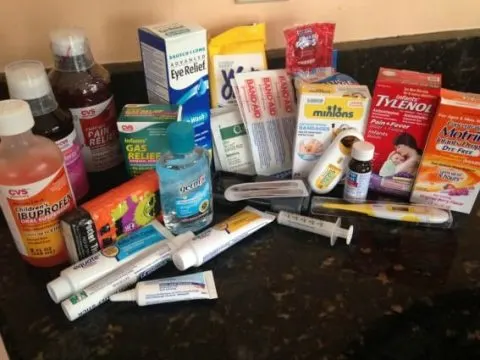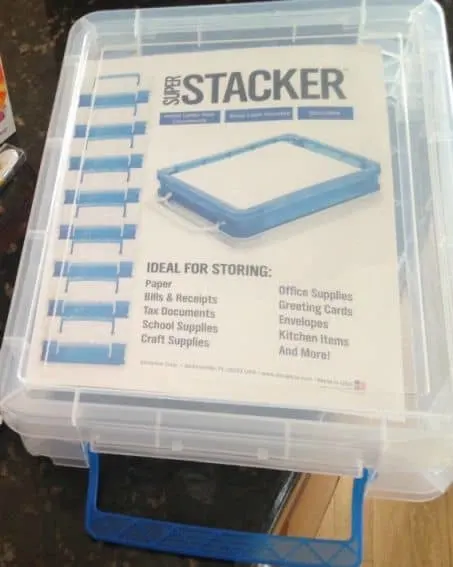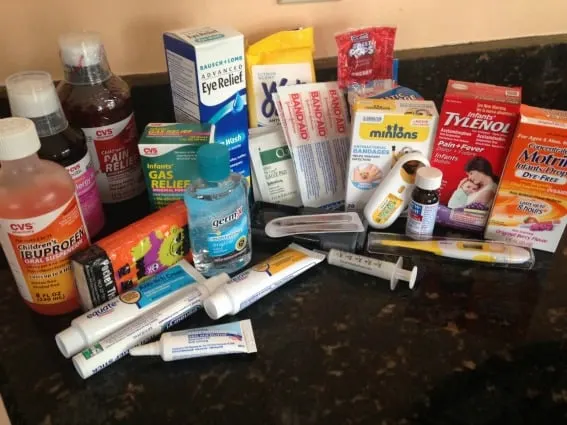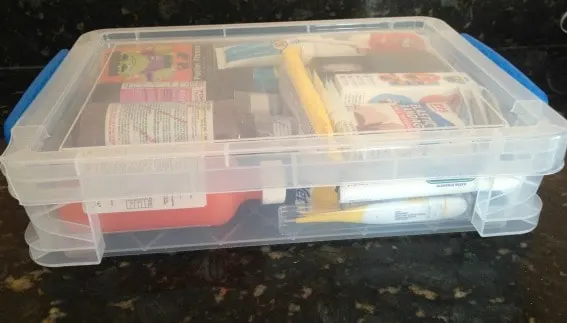The idea of traveling with babies or toddlers brings on nerve-wracking thoughts about packing. Those little ones come with more accoutrements than the Kardashian clan! Downsizing is key to travel happiness. but you definitely don’t want to forget your baby first aid kit!
Regardless of where you are a few days at Grandma’s, a week at the beach, a ski adventure, or a day at the park, it is a must to pack an infant or toddler first aid kit.
When my brood was small, our first aid kit got so much use. I have an active bunch, so minor and sometimes not-so-minor injuries were the norm. Add that to the viral infections they seem to be prone to at that ‘put anything and everything in your mouth’ stage and the first aid kit is vital!
First time flying with baby? Here is our guide to flying with a baby or toddler.
As a pharmacist and full-time mother, I know that being prepared with a baby first aid kit can be a lifesaver.
I recommend creating one packable kit that you can keep at the ready when packing for a trip. Simply throw the pre-packed first aid kit into your suitcase or the back of your car, and you are ready for almost anything – even if it means just breaking out the band-aid to make your little one feel better.
Are you thinking about camping with baby? Read our tips for camping with a baby or toddler.
Items to Include in Your Toddler or Baby First Aid Kit
The first step to putting together an indant or toddler first aid kit is to find either a large flip top or snappable plastic container large enough to hold all of the items. I prefer a more flat container like the Super Stacker that easily slips into a suitcase, backpack, or under a car seat.
Mark the container or assign a project to older children to decorate the box so that it is recognizable when you need it.
Baby and Toddler Travel First Aid Kit
First Aid Kit Essentials List
-
Bandages
Assorted sterile bandages and large size. The large size is indispensable for scrapped knees. Believe me you will be happy you have them. Decorated bandages always make the boo-boos feel better faster!
-
Liquid Bandage
Perfect for small wounds where the skin has disappeared like a blister. As it may sting upon application it is best used in older children.
-
Antiseptic cleanser
A quick squirt of an anti-infective on a superficial wound will help prevent later infection especially when soap and water are not nearby. Be sure not to use alcohol based cleansers as they will sting horribly and are not the best for open wounds. I like Neosporin on the Go for its small size.
-
Alcohol-based hand sanitizer or antibacterial wipes
Perfect for cleaning your own hands prior to dressing a wound or after cleaning up the inevitable car sick bag when there is no running water and soap.
-
Antibiotic ointment
Cover slight abrasions like skinned knees and stubbed toes with a bandage swiped with a spot of Neosporin or Bacitracin.
-
Sterile gauze pads
These are a life saver when there is more blood than you usually like to see. They also come in handy to clean tweezers.
-
Elastic Bandage Wrap
For older children these wraps work wonders on non-serious twisted ankles and knees. There is something magical about wrapping the joint that makes kids feel better. This falls under the TLC category.
-
Tweezers
We once had a child have a melt down on the way to a vacation due to a sliver. The banshee screams made me wish I had ear plugs for myself in the kit! Just recently we used them on vacation to pull several urchin spines out of a sand-covered foot!
-
Lighted magnifying glass
Mega important for that sea urchin spine removal or splinters!
-
Antihistamine
An antihistamine is used when someone has an allergic reaction to a food, insect bite, or topical irritant. Frequently antihistamines are used to stop itching reactions to topical irritants.
Mosquito bites are known to cause large welts and poison ivy can be a nuisance. Keep a pediatrician approved antihistamine in your kit. Topical formulations are perfect for insect bites. Liquid oral formulations are used for more significant situations such as food allergies.
Many children of this age haven’t been exposed to all of the possible food allergens. An oral antihistamine like diphenhydramine (Benadryl) can be important in a food allergen situation. If you suspect a food allergy, check with your physician for proper dosing should you need to use this medicine. Be sure to follow doctor’s orders.
-
Doser
An oral doser marked in milliliters is better than a cup. The delineations are more specific and there is less sticking of medicine to the side. Keep in mind that milliliters are the same as cc’s. There are 5mls per measuring teaspoonful of any liquid. NEVER use a silverware spoon for dosing medicine.
-
Pain reliever/fever reducer
These are indispensable should your little one develop a fever, like my kids always seem likely to do on a vacation. Use acetaminophen (Tylenol) or ibuprofen (Motrin).
Keep them both on hand because sometimes pediatricians will recommend you alternate them when a fever is stubborn or high. Be sure to follow the dosage on the container and remember that the concentration of infant medication is higher than toddler.
We usually kept the toddler concentration bottle because the volume of the container is greater than the infant concentrated bottle. If you are short on space in your kit, the infant one will do. Just be wary of the concentration and the correct dosage.
-
Thermometer
Now that my kids are older, I can tell by looking at them when they have a fever. It is some crazy type of acquired mom skill. When they were younger, I always needed to have confirmation with a thermometer and the actual quantification of their fever.
All kidding aside this is especially important when you have young babies less than 6 months. They are not fully vaccinated and fevers can be a big deal.
Many times pediatricians will want a number when you contact them on the phone so a plastic oral digital thermometer that reads quick is best. Don’t forget the covers!
-
Eye-Wash
Whether it’s a grain of sand or a finger poke, the eyewash should help clear it. Get the kind that has the eye cup included.
Be wary though because kids hate this stuff. It does not sting at all, but they think it will. Note that eyes that continually water or pain that will not go away requires a medical intervention.
-
Tissues
There will be crying and ensuing mess. A package of pocket tissues will help with the sniffles and tears.
-
Teething gel
Your baby will start teething while you are away. It is Murphy’s law. Just be prepared with some Baby Orajel to help you along the way.
-
Anti-gas drops
You will likely eat a new food while you are on vacation. So will your nursing baby or toddler. They may develop gas or colic. Having simethicone (Mylicon) with you will help out. Remember Murphy’s Law.
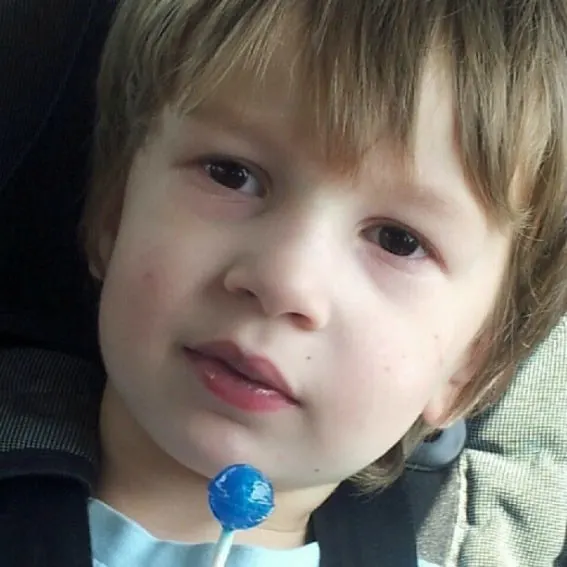
Child with Lollipop | Photo via Flickr
- Lollipop
Pack a lollipop or two in your kit. It will work wonders on tears, it’s a great distraction too!
-
Instant Ice Pack and Gloves
If you have room you might also consider an instant ice pack for the inevitable bonk on the head and a pair of latex free medical gloves. Here’s to an uneventful, but prepared trip!
Note: This article contains affiliate Amazon links
This article represents my opinion but is not intended to be a substitute for medical care or advice. Families should always consult their physician for specific medical recommendations.
- 10 Great Places to Visit in New England with Family - June 9, 2025
- 18 Great Things to do in Rhode Island with Kids on a Family Vacation - June 23, 2025
- 12 Spectacular New England Fall Road Trips for Families - September 19, 2024

